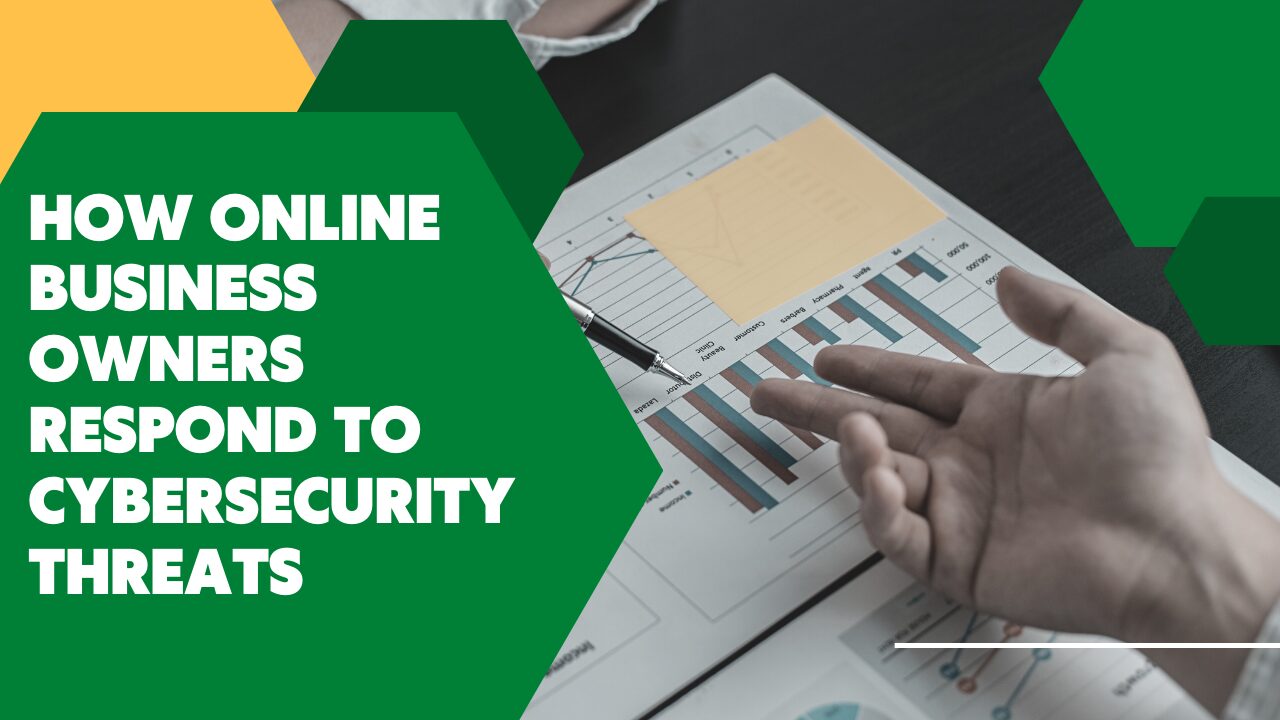How Online Business Owners Respond to Cybersecurity Threats: Effective Strategies and Solutions
Cybersecurity threats have become a pressing concern for online business owners. As the prevalence and complexity of cyber attacks continue to grow, these entrepreneurs must understand and address potential business risks. The ability to respond effectively to cybersecurity threats not only protects valuable data and assets but also helps maintain trust with customers and partners.
Understanding the types of cybersecurity threats is the first step in crafting a robust response plan. Whether it’s ransomware, phishing, or DDoS attacks, online business owners need to familiarize themselves with cyber adversaries’ tactics and methods. With that knowledge, they can develop strategic response plans, invest in preventive measures, and establish a comprehensive incident management system.
Collaborating and sharing threat intelligence with peers, investing in a skilled cybersecurity workforce, and adhering to legal and compliance obligations are additional components of a holistic approach to addressing the constantly evolving landscape of cyber risks. By implementing these strategies, online business owners can stay one step ahead in the ongoing battle against cyber threats.
Key Takeaways
- Understanding cybersecurity threats helps build a strong response plan
- Investing in prevention and incident management is essential
- Collaboration, skilled workforce, and compliance play pivotal roles in addressing cyber risks
Understanding Cybersecurity Threats
This section will explore the different types of threats and the potential consequences of a security breach.
Types of Cybersecurity Threats
- Phishing: Phishing attacks involve sending fraudulent emails or messages that appear to be from trusted sources. These are designed to trick you into providing sensitive information, such as passwords or financial details. Be cautious of unexpected messages and verify the source before giving any information.
- Malware: Malicious software, or malware, can infiltrate your systems and wreak havoc. Types of malware include viruses, worms, trojan horses, and ransomware. To mitigate the risk of malware infections, always keep your software and operating systems up-to-date and use reputable antivirus solutions.
- DDoS Attacks: Distributed denial-of-service (DDoS) attacks overwhelm your website or server with excessive traffic, rendering it inaccessible to users. Implementing proper security measures, such as using a robust hosting provider and deploying DDoS protection services, can help protect your online business against these attacks.
- Data Breaches: Cybercriminals may attempt to gain unauthorized access to your sensitive data. This can include personal customer information, financial records, or other valuable information. Ensuring a solid security perimeter, including encryption and access controls, is essential for safeguarding your data.
Impact of Cybersecurity Breaches
- Financial Losses: Cybersecurity breaches can lead to economic losses from lost business, ransom demands, or fines imposed by regulators. Being proactive in your security practices can help minimize the potential financial impact.
- Reputation Damage: A breach can severely damage your business’s reputation, with customers losing trust in your ability to protect their information. Investing in robust cybersecurity measures helps demonstrate your commitment to customer privacy and security.
- Operational Disruptions: Cyberattacks can cause significant downtime and disruptions to your business operations. Ensuring you have a comprehensive incident response plan can help reduce any impact of cyber incidents.
- Legal Consequences: Failure to protect sensitive customer information adequately may lead to regulatory penalties, lawsuits, and other legal consequences. Familiarize yourself with industry-specific regulations and implement the necessary security measures.

Strategic Response Planning
Risk Assessment
To effectively respond to cybersecurity threats, you must identify potential risks and evaluate their impact on your online business. Conduct a thorough risk assessment by:
- Mapping out your digital infrastructure.
- Identifying potential vulnerabilities, attack vectors, and valuable assets.
- Assessing the likelihood and severity of threats.
- Prioritizing risks based on their potential impact.
This process allows you to allocate resources effectively and design mitigation strategies tailored to your needs.
Developing a Security Policy
Your next step is developing a comprehensive security policy outlining acceptable resource use, password protocols, and incident response procedures. This policy should include:
- Purpose: Define the company’s commitment to maintaining a secure online environment.
- Scope: Specify the personnel, systems, and facilities covered by the policy.
- Roles and Responsibilities: Clarify the duties and responsibilities of various personnel involved in cybersecurity.
- Acceptable Use Policy: Detail the expectations for appropriate use of company-owned IT resources.
- Password Management: Establish password complexity requirements and update schedules.
- Incident Response Plan: Create a clear roadmap for responding to security incidents.
Communicate the policy to all relevant personnel and provide the necessary training to ensure compliance and effectiveness.
Implementation of Security Protocols
To bolster your online business against cyber threats, you must implement the following security protocols in line with your security policy:
- Access Controls: Restrict user access to sensitive systems and data based on the principle of least privilege.
- Encryption: Utilize strong encryption for data in transit and at rest to protect sensitive information.
- Firewalls: Employ network-level firewalls to block unauthorized access and malicious traffic.
- Antivirus Software: Install and regularly update antivirus solutions on all devices to protect against malware.
- Software Updates: Maintain current software versions and apply security patches promptly.
- Backup and Recovery: Implement regular data backup and recovery processes to safeguard information and ensure business continuity.
By following these best practices, you’ll be better positioned to protect your online business against cyber threats and safeguard your customers’ data. Remember to constantly review and update your strategic response planning in the face of an ever-evolving threat landscape.
Preventive Measures
Employee Training and Awareness
Proper employee training and awareness of cybersecurity threats play a critical role in safeguarding your online business. Start by conducting regular training sessions to ensure your employees are familiar with potential risks, such as phishing attacks and social engineering tactics. Use checklists and infographics to help employees understand and retain important information.
- Encourage employees to use strong, unique passwords for all accounts
- Adopt multi-factor authentication to deter unauthorized access
- Educate employees on identifying phishing emails and malicious links
Data Encryption and Backup Strategies
To protect your sensitive data, it’s essential to implement reliable data encryption methods. Encrypting your data means converting it into a format only authorized users can access. In addition, establish a robust backup strategy that includes:
- Regularly backing up all critical data
- Storing backups in secure, offsite locations
- Testing backup restoration processes periodically
| Data Protection | Description |
|---|---|
| Encryption | Secure data transmission/storage |
| Backup | Regular backups of important data |
| Offsite Storage | Store backups in safe locations |
Regular Software Updates
Staying up-to-date with software updates is crucial for protecting your online business from evolving cybersecurity threats. Updates typically include security improvements designed to patch vulnerabilities and prevent potential attacks. To keep your software up-to-date:
- Enable automatic updates for operating systems and applications
- Maintain an inventory of all software and devices in use
- Regularly communicate the importance of updates to employees
By taking these preventive measures, you can significantly reduce the risk of cyber-attacks and build a solid foundation for your online business’s cybersecurity defenses.
Incident Response and Management
Detection and Analysis
The first step in managing cybersecurity threats is detecting and analyzing the incident. As an online business owner, you should always monitor your network traffic and look for suspicious activity. Implementing intrusion detection systems (IDS) can help you catch anomalies in your network. Make use of threat intelligence feeds, which can be integrated into your security tools and provide indicators of potential threats.
Some forensic tools you might consider are:
- Wireshark: Analyze network traffic to detect possible intrusions
- Volatility: Examine memory dumps and identify malware presence
- YARA: Create and apply rules to identify and classify malware samples
Containment, Eradication, and Recovery
Once a threat is detected and analyzed, it’s essential to contain it and prevent further damage. To do this, you might need to isolate affected systems, enforce network segmentation, apply patches, or implement other measures.
You should also create and maintain a comprehensive backup and recovery strategy for your online business. Regularly test your backups to ensure they are functional and stored securely. Include the following steps in your containment plan:
- Isolate affected systems to prevent the spread of the attack
- Eradicate malware or malicious activities by removing them from your systems
- Recover your operations by restoring affected systems, verifying data integrity, and applying necessary patches
Post-Incident Review
After the incident is resolved, learning from the experience and improving your security measures is crucial. Analyze what went wrong, identify vulnerabilities or gaps in your defense, and implement appropriate changes to your cybersecurity plan.
Some areas to focus on in your post-incident review include:
- Evaluate your detection and analysis methods and improve them if necessary
- Review your containment and eradication efforts, noting how well they mitigated the damage
- Assess the recovery process and identify any delays or issues that arose
- Update your policies and procedures based on what you learned from the incident
Collaboration and Sharing of Information
Engaging with Cybersecurity Communities
As an online business owner, you should actively participate in cybersecurity communities to stay informed about the latest threats and solutions. Engaging with these communities can help you learn from the experiences of others and discover new tools and strategies to protect your business. Some effective ways to connect with cybersecurity experts and fellow business owners include joining online forums, attending webinars, and following social media groups related to your industry and cybersecurity.
For instance, you might consider joining these popular communities:
- Reddit: r/netsec, r/cybersecurity
- LinkedIn Groups: Information Security Community, Cyber Security Professionals
- Industry-specific forums: MSPAlliance, Cloud Security Alliance
Collaborating with other businesses and experts can help you build a more robust defense against cyber threats.
Public-Private Partnerships
Enhance your cybersecurity through public-private partnerships. By working with both government and private sector entities, you can access additional resources, information, and support to protect your online business. These partnerships typically involve sharing information about threats, vulnerabilities, and best practices, which can benefit all parties involved.
Here are some notable public-private partnerships you can look into:
| Partnership | Description |
|---|---|
| Information Sharing and Analysis Centers (ISACs) | Member-driven organizations that gather, analyze, and share information across various sectors to improve security and resilience. |
| National Cybersecurity Center of Excellence (NCCoE) | A U.S. government resource that provides cybersecurity solutions and best practices by collaborating with businesses, researchers, and academia. |
| Cybersecurity Information Sharing Act (CISA) | A U.S. law encourages the sharing of cybersecurity threat information between private companies and the federal government to protect critical infrastructures. |
By partnering with these entities, you can improve your business’s cybersecurity measures and stay ahead of emerging threats. A collaborative approach is key to combating cyber threats, and sharing information can contribute to improving cybersecurity strategies for all.
Investment in Cybersecurity
Budgeting for Cybersecurity Initiatives
As an online business owner, prioritizing your investment in cybersecurity is crucial to protect your business from potential threats. Begin by allocating a portion of your annual budget specifically for cybersecurity initiatives. This budget should include costs for regular security audits, employee cybersecurity training, and security incident response plans. Maintain a contingency fund for unforeseen expenses related to security incidents, which can help mitigate damages.
Advanced Security Technologies
Embracing advanced security technologies is another important step in responding to cybersecurity threats. Some key technologies to consider for your online business include:
- Endpoint protection: Implement advanced solutions like next-generation antivirus software and endpoint detection and response (EDR) tools to protect all devices connected to your network.
- Multi-factor authentication (MFA): MFA is required to access sensitive systems or data, adding an extra layer of security that goes beyond simple passwords.
- Encryption: Utilize encryption for all stored and transmitted data to protect sensitive information from unauthorized access.
- Intrusion detection and prevention systems (IDPS): Implement IDPS to monitor your network and systems, identifying and preventing potential security breaches.
- Security Information and Event Management (SIEM): Deploy a SIEM solution to collect, analyze, and respond to security events in real time, streamlining your security incident response.
Investing in advanced security technologies can strengthen your online business’s defenses and effectively respond to cybersecurity threats. Remember that cybersecurity is an ongoing process, and staying informed on the latest developments is essential for maintaining a secure and successful business.
Legal and Compliance Obligations
Becoming Familiar with Regulatory Requirements
As an online business owner, you are responsible for understanding the regulatory requirements on cybersecurity in your industry. These requirements vary depending on your location, industry, and size. Some of the major regulations you should be familiar with include:
- GDPR (General Data Protection Regulation) for businesses operating in the European Union or serving EU citizens
- HIPAA (Health Insurance Portability and Accountability Act) for businesses in the healthcare industry in the United States
- PCI DSS (Payment Card Industry Data Security Standard) for businesses that process credit card transactions
To stay compliant, you should:
- Assess the impact of these regulations on your business
- Implement the required security measures
- Conduct regular audits to ensure ongoing compliance
Reporting and Accountability
Meeting your legal and compliance obligations also involves accountability for your cybersecurity posture. As a business owner, you must:
- Report incidents: Regulations such as GDPR require businesses to notify their supervisory authority and affected customers within 72 hours of becoming aware of a data breach.
- Maintain records: You should keep thorough records of your cybersecurity measures, risk assessments, and incident response plans.
- Assign roles: Appointing a Data Protection Officer (DPO) or a Chief Information Security Officer (CISO) can help ensure a dedicated individual oversees your compliance efforts.
Adapting to Evolving Threats
You must constantly adapt to evolving cybersecurity threats as an online business owner. This section will discuss the importance of continuous monitoring, threat intelligence analysis, and proactive defense strategies to help protect your business.
Continuous Monitoring
To stay ahead of cybercriminals, you must implement continuous monitoring of your IT systems and networks. This involves:
- Regularly scanning for vulnerabilities
- Identifying unauthorized access attempts
- Detecting suspicious activities
Continuous monitoring allows you to quickly identify and respond to potential threats before they escalate.
Threat Intelligence Analysis
You should invest in threat intelligence analysis to stay informed about the latest cybersecurity threats. This process involves:
- Gathering data on potential threats from various sources
- Analyzing the data to identify patterns and trends
- Sharing the findings with relevant stakeholders to aid in decision-making
Proactive Defense Strategies
In addition to monitoring and intelligence analysis, it’s crucial to establish proactive defense strategies to protect your business from cyber-attacks. Some strategies include:
- Regular software updates: Keep your operating systems, applications, and security software updated with the latest patches.
- Employee training: Educate your team on best cybersecurity practices and teach them to recognize phishing emails and other common attacks.
- Multifactor authentication (MFA): Implement MFA to protect your online accounts.
- Backup and recovery: Regularly back up your data to ensure you can quickly restore operations during an attack.








